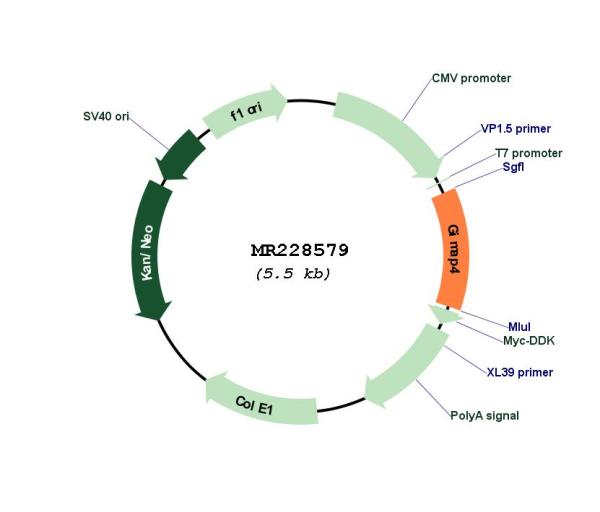Gimap4 (NM_001243199) Mouse Tagged ORF Clone
CAT#: MR228579
- TrueORF®
Gimap4 (myc-DDK-tagged) - Mouse GTPase, IMAP family member 4 (Gimap4), transcript variant 3
AAV Particle: DDK
"NM_001243199" in other vectors (1)
Interest in protein/lysate? Submit request here!
USD 198.00
Specifications
| Product Data | |
| Type | Mouse Tagged ORF Clone |
| Tag | Myc-DDK |
| Symbol | Gimap4 |
| Synonyms | AU019574; E430007K16Rik; I; Ian-1; Ian1; Imap4 |
| Vector | pCMV6-Entry |
| E. coli Selection | Kanamycin (25 ug/mL) |
| Mammalian Cell Selection | Neomycin |
| Sequence Data |
>MR228579 ORF sequence
Red=Cloning site Blue=ORF Green=Tags(s) TTTTGTAATACGACTCACTATAGGGCGGCCGGGAATTCGTCGACTGGATCCGGTACCGAGGAGATCTGCC GCCGCGATCGCC ATGGAAGTCCAGTGCGGTGGTGCGGGGTTCATCCCAGAAAGTTCAAGGAGCAGCCATGAGCTTGGAAACC AAGATCAAGGAATTCCCCAACTGAGAATTGTCTTACTTGGAAAAACTGGAGCAGGAAAGAGTTCAACAGG GAACAGTATCCTTGGGGAAAAAGTGTTTAATTCTGGCATTTGTGCAAAATCCATCACCAAGGTCTGTGAA AAAAGGGTGAGCACCTGGGATGGGAAAGAGCTTGTTGTCGTGGATACACCTGGTATTTTTGACACTGAGG TACCAGATGCTGACACACAAAGGGAGATCACTCGCTATGTTGCCCTGACCTCTCCAGGGCCTCATGCTCT GCTCCTGGTAGTTCCACTGGGGCGTTATACTGTGGAAGAACACAAGGCTACACAGAAAATTCTGGACATG TTTGGAAAACAGGCTAGAAGATTCATGATTCTCTTGCTCACCAGGAAGGATGACTTAGAAGACACTGATA TCCATGAGTACTTAGAGAAGGCTCCTAAATTCTTTCAAGAGGTGATGCATGAGTTCCAGAATCGCTACTG TTTGTTCAACAACAGAGCCTCAGGCGCTGAAAAGGAAGAGCAGAAGATGCAATTGTTGACCTTGGTCCAG AGCATGTTTCTGTCTTCCAGGATGAAG ACGCGTACGCGGCCGCTCGAGCAGAAACTCATCTCAGAAGAGGATCTGGCAGCAAATGATATCCTGGATT ACAAGGATGACGACGATAAGGTTTAA >MR228579 protein sequence
Red=Cloning site Green=Tags(s) MEVQCGGAGFIPESSRSSHELGNQDQGIPQLRIVLLGKTGAGKSSTGNSILGEKVFNSGICAKSITKVCE KRVSTWDGKELVVVDTPGIFDTEVPDADTQREITRYVALTSPGPHALLLVVPLGRYTVEEHKATQKILDM FGKQARRFMILLLTRKDDLEDTDIHEYLEKAPKFFQEVMHEFQNRYCLFNNRASGAEKEEQKMQLLTLVQ SMFLSSRMK TRTRPLEQKLISEEDLAANDILDYKDDDDKV |
| Restriction Sites |
SgfI-MluI
Cloning Scheme for this gene
Plasmid Map

|
| ACCN | NM_001243199 |
| ORF Size | 660 bp |
| OTI Disclaimer | The molecular sequence of this clone aligns with the gene accession number as a point of reference only. However, individual transcript sequences of the same gene can differ through naturally occurring variations (e.g. polymorphisms), each with its own valid existence. This clone is substantially in agreement with the reference, but a complete review of all prevailing variants is recommended prior to use. More info |
| OTI Annotation | This clone was engineered to express the complete ORF with an expression tag. Expression varies depending on the nature of the gene. |
| Product Components | The ORF clone is ion-exchange column purified and shipped in a 2D barcoded Matrix tube containing 10ug of transfection-ready, dried plasmid DNA (reconstitute with 100 ul of water). |
| Reconstitution | 1. Centrifuge at 5,000xg for 5min. 2. Carefully open the tube and add 100ul of sterile water to dissolve the DNA. 3. Close the tube and incubate for 10 minutes at room temperature. 4. Briefly vortex the tube and then do a quick spin (less than 5000xg) to concentrate the liquid at the bottom. 5. Store the suspended plasmid at -20°C. The DNA is stable for at least one year from date of shipping when stored at -20°C. |
| Reference Data | |
| RefSeq | NM_001243199.1, NP_001230128.1 |
| RefSeq Size | 1365 bp |
| RefSeq ORF | 660 bp |
| Locus ID | 107526 |
| UniProt ID | Q99JY3 |
| Cytogenetics | 6 B2.3 |
| MW | 24.6 kDa |
| Gene Summary | This gene encodes a protein belonging to the GTP-binding superfamily and to the immuno-associated nucleotide (IAN) subfamily of nucleotide-binding proteins. This gene exists within a cluster of other related genes located on mouse chromosome 6. This family member encodes a lymphoid signaling protein that functions to accelerate programmed T-cell death, which appears to correlate with the phosphorylation status of the protein. Alternative splicing results in multiple transcript variants. [provided by RefSeq, Aug 2011] |
Documents
| Product Manuals |
| FAQs |
| SDS |
Resources
Other Versions
| SKU | Description | Size | Price |
|---|---|---|---|
| MC226368 | Gimap4 (untagged) - Mouse GTPase, IMAP family member 4 (Gimap4), transcript variant 3 |
USD 330.00 |
{0} Product Review(s)
Be the first one to submit a review






























































































































































































































































 Germany
Germany
 Japan
Japan
 United Kingdom
United Kingdom
 China
China


